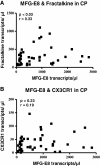The impact of MFG-E8 in chronic pancreatitis: potential for future immunotherapy?
- PMID: 23324439
- PMCID: PMC3556065
- DOI: 10.1186/1471-230X-13-14
The impact of MFG-E8 in chronic pancreatitis: potential for future immunotherapy?
Abstract
Background: The glycoprotein MFG-E8 mediates phagocytic clearance of apoptotic cells and influences the pathogenesis and progression of inflammatory diseases. MFG-E8 was shown to attenuate the progression of inflammation and to improve survival in septic rats. Accumulating evidence suggests an immunomodulatory link between MFG-E8 and the pro-inflammatory chemokine fractalkine, which may determine the severity of pain, fibrosis, and inflammation in chronic pancreatitis (CP).
Methods: The expression and localization of MFG-E8 was investigated in CP (n=62), and normal pancreas (NP; n=34) by QRT-PCR, Western-blot and immunohistochemistry analyses. Results were correlated with mRNA expression of fractalkine, CX3CR1, and with the presence and degree of pain and fibrosis. Human pancreatic stellate cells (hPSCs) were isolated from CP tissues and evaluated for MFG-E8 mRNA expression after fractalkine stimulation.
Results: MFG-E8-mRNA was significantly overexpressed in CP and isolated hPSCs when compared to NP. Western-blot and immunohistochemistry analysis confirmed accumulation of MFG-E8 in CP, with noticeably increased MFG-E8 immunoreactivity in tubular complexes. MFG-E8 expression correlated significantly with fractalkine expression, severe fibrosis, and the presence of pain in CP patients. Stimulation of hPSCs with fractalkine led to a significant increase in MFG-E8 expression.
Conclusions: In the present study, we demonstrated for the first time that MFG-E8 is significantly up-regulated in CP patients and together with fractalkine correlated noticeably with severe fibrosis and the presence of pain. hPSCs overexpress MFG-E8 upon fractalkine stimulation in vitro, which underlines the suggested immunmodulatory link in CP and may be a key mechanism in CP fibrogenesis and pain generation. Taken together, these novel findings suggest that MFG-E8 blockade may be a promising tool for future immunotherapy in CP to attenuate both fibrosis and pain sensation.
Figures





Similar articles
-
Pancreatic stellate cells and CX3CR1: occurrence in normal pancreas and acute and chronic pancreatitis and effect of their activation by a CX3CR1 agonist.Pancreas. 2014 Jul;43(5):708-19. doi: 10.1097/MPA.0000000000000109. Pancreas. 2014. PMID: 24681877 Free PMC article.
-
MFG-E8 Plays an Important Role in Attenuating Cerulein-Induced Acute Pancreatitis in Mice.Cells. 2021 Mar 25;10(4):728. doi: 10.3390/cells10040728. Cells. 2021. PMID: 33806041 Free PMC article.
-
Neural fractalkine expression is closely linked to pain and pancreatic neuritis in human chronic pancreatitis.Lab Invest. 2009 Mar;89(3):347-61. doi: 10.1038/labinvest.2008.170. Epub 2009 Jan 19. Lab Invest. 2009. PMID: 19153557
-
Review: milk fat globule-EGF factor 8 expression, function and plausible signal transduction in resolving inflammation.Apoptosis. 2011 Nov;16(11):1077-86. doi: 10.1007/s10495-011-0630-0. Apoptosis. 2011. PMID: 21901532 Review.
-
Emerging Roles for MFG-E8 in Synapse Elimination.J Neurochem. 2025 Feb;169(2):e70009. doi: 10.1111/jnc.70009. J Neurochem. 2025. PMID: 39891478 Review.
Cited by
-
MFG-E8, a novel homeostatic regulator of osteoclastogenesis.Inflamm Cell Signal. 2014;1(5):e285. doi: 10.14800/ics.285. Inflamm Cell Signal. 2014. PMID: 26052544 Free PMC article.
-
Desmoplastic Crosstalk in Pancreatic Ductal Adenocarcinoma Is Reflected by Different Responses of Panc-1, MIAPaCa-2, PaTu-8902, and CAPAN-2 Cell Lines to Cancer-associated/Normal Fibroblasts.Cancer Genomics Proteomics. 2021 May-Jun;18(3):221-243. doi: 10.21873/cgp.20254. Cancer Genomics Proteomics. 2021. PMID: 33893076 Free PMC article.
-
Pancreatic stellate cells and CX3CR1: occurrence in normal pancreas and acute and chronic pancreatitis and effect of their activation by a CX3CR1 agonist.Pancreas. 2014 Jul;43(5):708-19. doi: 10.1097/MPA.0000000000000109. Pancreas. 2014. PMID: 24681877 Free PMC article.
-
MFG-E8 Plays an Important Role in Attenuating Cerulein-Induced Acute Pancreatitis in Mice.Cells. 2021 Mar 25;10(4):728. doi: 10.3390/cells10040728. Cells. 2021. PMID: 33806041 Free PMC article.
-
Regulation of osteoclast homeostasis and inflammatory bone loss by MFG-E8.J Immunol. 2014 Aug 1;193(3):1383-91. doi: 10.4049/jimmunol.1400970. Epub 2014 Jun 23. J Immunol. 2014. PMID: 24958900 Free PMC article.
References
-
- DiMagno EP. A short, eclectic history of exocrine pancreatic insufficiency and chronic pancreatitis. Gastroenterology. 1993;104:1255–1262. - PubMed
-
- Michalski CW, Gorbachevski A, Erkan M, Reiser C, Deucker S, Bergmann F, Giese T, Weigand M, Giese NA, Friess H, Kleeff J. Mononuclear cells modulate the activity of pancreatic stellate cells which in turn promote fibrosis and inflammation in chronic pancreatitis. J Transl Med. 2007;5:63. doi: 10.1186/1479-5876-5-63. - DOI - PMC - PubMed
MeSH terms
Substances
LinkOut - more resources
Full Text Sources
Other Literature Sources
Research Materials
Miscellaneous

